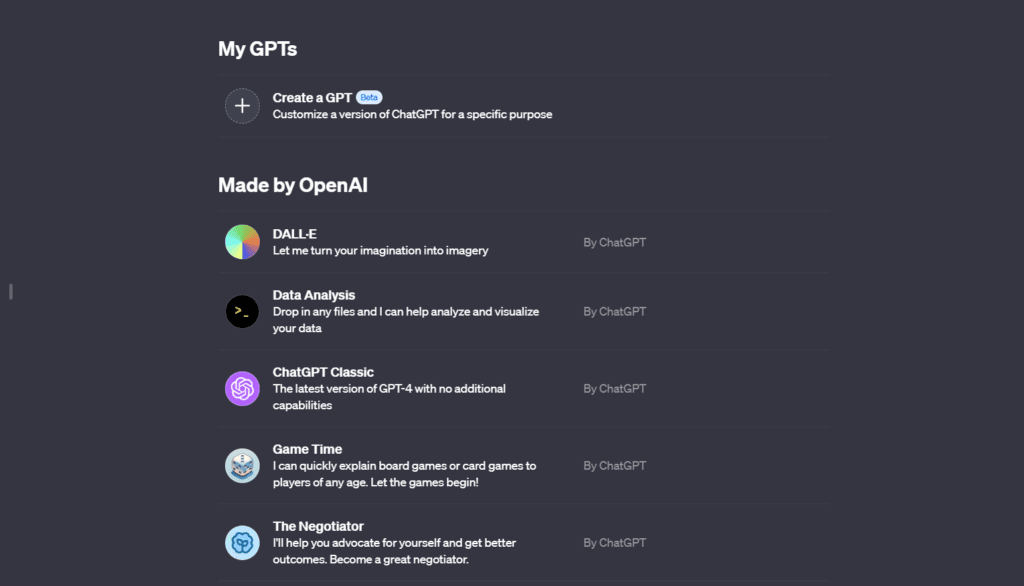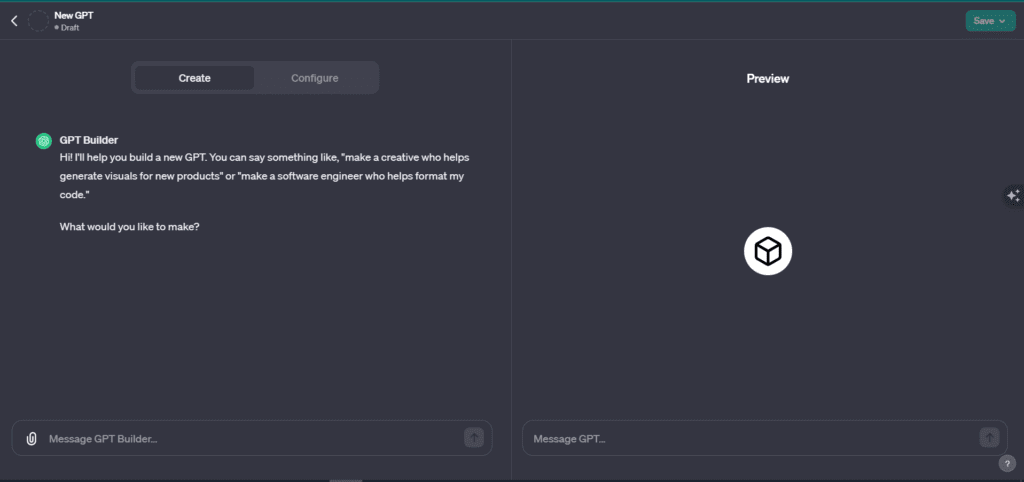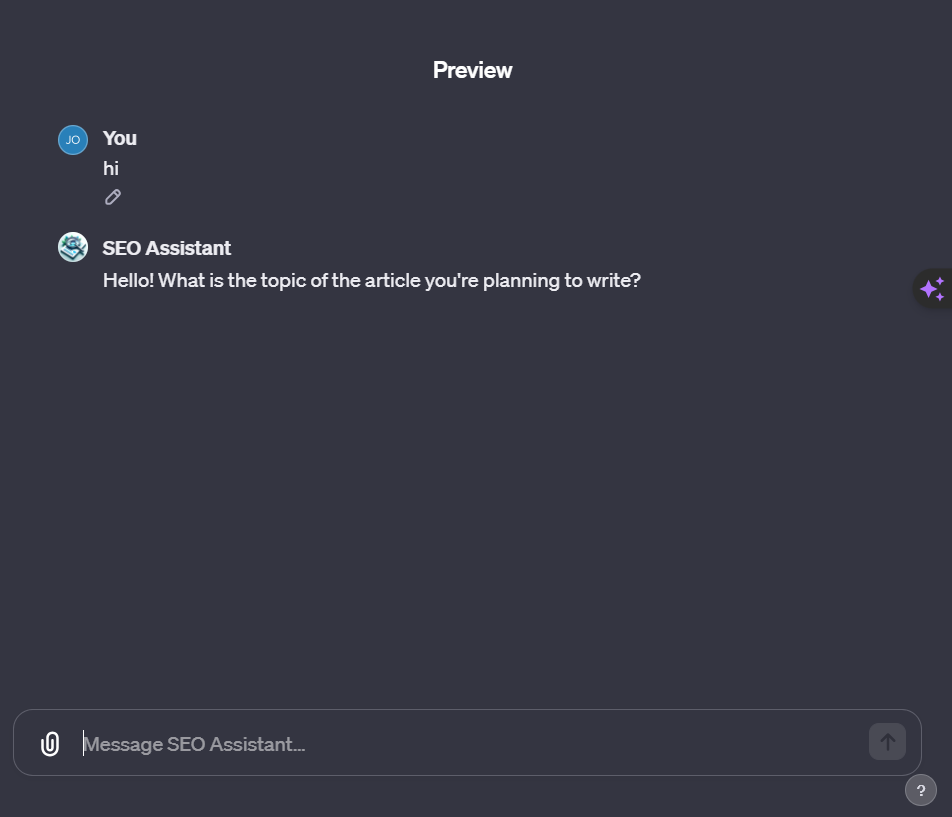Customize GPT-4 represents a significant leap forward in the realm of artificial intelligence. It’s a process that combines technical acumen with creative experimentation, resulting in AI models that are not just intelligent but also perfectly tuned to individual objectives. Whether it’s for enhancing business processes, creating engaging content, or analyzing complex data sets, the journey of customizing GPT-4 is an adventure in precision, efficiency, and innovation.
Understanding the Basics of GPT-4 Customization
In this section, we'll identify the concept of Customize GPT-4 , a crucial aspect for anyone looking to tailor this advanced AI to their specific needs.
GPT Models vs. ChatGPT vs. Custom GPTs
It's essential to distinguish between these terms. GPT Models, like GPT-4, are the underlying AI engines powering various applications. ChatGPT refers to the chatbot application using a GPT model. Custom GPTs or Customize GPT-4 are personalized versions of ChatGPT, modified for specific tasks or preferences.
Customization Requirements
To start Customize GPT-4 , you need a few key things. Access to a computer and a paid ChatGPT subscription are the basics. But the real magic happens when you dive into the GPT Builder. This tool allows you to shape your GPT-4 model without needing deep coding knowledge. It's user-friendly and lets you instruct the AI in natural language or through more detailed prompt engineering.
Why Customize?
Customization allows you to align the GPT-4's capabilities with your unique requirements. Whether it's creating an AI that excels in generating SEO-optimized blog content or one that can analyze complex data sets, tailoring your GPT-4 model ensures that it performs optimally for the task at hand.
Understanding these basics sets the stage for the more hands-on aspects of GPT-4 customization. It's a blend of technical know-how and creative experimentation, leading to AI models that are not just smart, but also perfectly attuned to your specific objectives.
Setting Up for Customization: Tools and Resources
When preparing to customize GPT-4 model, knowing the right tools and resources is key. Here’s what you need to get started:
GPT Builder
This is your primary tool for customizing GPT-4. The GPT Builder allows you to interact with the model in a user-friendly interface, where you can guide its learning and behavior without needing in-depth programming skills. You can use natural language to instruct the AI, making the process accessible even to those without a technical background.
Resources for Customization
Beyond the GPT Builder, you’ll need relevant datasets and reference materials. These could include text files, PDFs, or images relevant to your desired application. For example, if you’re creating an SEO-optimized blogging AI, you might include articles, keyword lists, and SEO guidelines as reference materials.
Computational Resources
Depending on the complexity of your customization, you may require substantial computational power. This is particularly true if you’re training the model with large datasets or aiming for a highly specialized function.
Knowledge Materials
Uploading reference materials to the GPT Builder is crucial. These materials help the AI understand the context and specifics of the task, leading to more accurate and relevant outputs.
Having the right setup is crucial for successful customization. It ensures that you not only create a GPT-4 model that’s tailored to your needs but also one that is efficient and effective in its designated tasks.
Customize GPT-4 for Blogging and SEO Optimization
Customize GPT-4 for SEO-optimized blogging involves a nuanced approach to prompt engineering and resource selection. Here's how you can do it:
Here is the image that shows how to start making your own customize GPT-4 so at the top of the content you will see Create a GPT click on it and a new window appears

Defining SEO Goals
Begin by clearly defining your SEO objectives. Are you focusing on specific keywords, topics, or a particular audience? Your goals will guide the customization process.
Crafting SEO-Optimized Prompts
Your prompts should be meticulously designed to encapsulate SEO best practices. Include relevant keywords, desired article length, tone, and structure. For instance, a prompt might be, “Write a 700-word engaging article on the health benefits of Mediterranean diet, incorporating keywords 'nutritional value', 'Mediterranean recipes', and 'healthy eating'.”
Once you open the GPT-Builder copy paste the above prompt or you can see what I said to GPT that what should I need




Utilizing SEO Resources
Upload SEO guides, high-ranking articles, keyword lists, and competitor content as reference materials. These resources will help the model understand the nuances of SEO writing.
Training and Fine-Tuning
Use the GPT Builder to train your model with these prompts and resources. Monitor the outputs and continually refine your prompts and training materials based on performance.
Incorporating Analytics
Consider integrating tools for analytics to track the performance of the content generated by your model. This will help in further fine-tuning the model to align with evolving SEO trends.
Regular Updates
SEO is dynamic, so regularly update your prompts and resources to keep up with the latest trends and algorithm changes.
By following these steps, you can create a GPT-4 model that is adept at producing SEO-optimized blog content, tailored to your specific needs and goals in content strategy.
Other Custom GPT-4 Applications
While customize GPT-4 for SEO-optimized blogging is a powerful use case, the model's versatility extends to many other fascinating applications. Here are some examples of how GPT-4 can be tailored for various specialized tasks:
- Geopolitics Analysis Bot: This model can provide nuanced analyses of complex global issues. It's trained to offer balanced insights into international conflicts, considering historical contexts and current geopolitical dynamics.
- Apology Letter Generator: Designed for crafting personalized apology letters, this model adapts to various scenarios, providing thoughtful, empathetic responses.
- AI Business Consultant: This version of GPT-4 helps integrate AI into diverse business settings, suggesting innovative ways to enhance efficiency and productivity.
- Social Media Content Analyzer: A custom model trained to evaluate social media posts for potential offensiveness or brand safety issues, showcasing GPT-4's adaptability to the nuances of public communication.
These examples demonstrate the broad range of possibilities with custom GPT-4 models. From business and marketing to social media management and international relations, the potential applications are vast and varied, limited only by one's imagination and the specificity of the training data and prompts used.
Testing and Refining Your Custom Model
After setting up your customize GPT-4 model, the next crucial step is testing and refining it. Here's how you can do it effectively
- Initial Testing: Start by giving your model various prompts related to your customization goals. For instance, if it’s for SEO blogging, check how well it integrates keywords and follows the desired content structure.
- Analyze the Outputs: Look closely at the responses. Are they meeting your expectations? Are the keywords used correctly? Is the content engaging and relevant?
- Refine the Prompts: Based on your observations, tweak your prompts. Maybe add more specific instructions or adjust the tone you're asking for.
- Update Training Materials: If the model is consistently missing the mark, consider updating your reference materials. Add more examples of what you're aiming for.
- Iterative Process: Remember, refining a custom GPT-4 model is an iterative process. It may take several rounds of testing and adjusting to get it just right.
- Seek Feedback: Don’t hesitate to get external opinions. Sometimes, what makes sense to you might not resonate with others.
- Keep Track of Changes: Document your changes and their effects. This will help you understand what works best for your model.
By following these steps and patiently tweaking your model, you can fine-tune its performance to align closely with your specific needs and goals.
Final Thoughts
In this guide, we've journeyed through the exciting process of customize GPT-4 for specific applications, from SEO-optimized blogging to various other innovative uses. Customize GPT-4, as we've seen, involves understanding its capabilities, using the right tools and resources, crafting effective prompts, and engaging in a rigorous process of testing and refinement. The potential of GPT-4 is vast, limited only by our creativity and the specificity of our goals. Whether for business, creative writing, or specialized analytics, the power to tailor this advanced AI to our unique needs opens up a world of possibilities. So, embrace the opportunity to experiment, explore, and transform the way you engage with AI technology!
Frequently Asked Questions (FAQs) about Custom GPT-4 Models
What is Customize GPT-4 and why is it important?
Customize GPT-4 refers to the process of personalizing the GPT-4 AI model for specific tasks or preferences. It is important because it allows the GPT-4 to align more closely with individual or business-specific needs, enhancing its effectiveness in specific applications.
What are the differences between GPT Models, ChatGPT, and Customize GPTs?
- GPT Models: These are the base AI engines, like GPT-4, powering various AI applications.
- ChatGPT: This is an application using a GPT model, primarily for chatbot functions.
- Customize GPTs: These are personalized versions of GPT models, such as ChatGPT, modified for specific tasks.
What do I need to start customize GPT-4 model?
To customize GPT-4 model, you need a computer, a paid ChatGPT subscription, and access to the GPT Builder tool. This tool allows for model customization without deep coding knowledge and uses natural language or prompt engineering for instructions.
How can I customize GPT-4 for SEO-optimized blogging?
To customize GPT-4 for SEO blogging, start by defining your SEO goals and crafting detailed, SEO-optimized prompts. Utilize relevant SEO resources such as guides, keyword lists, and high-ranking articles for training, and continually refine your model based on performance analytics.
What are some other applications of customize GPT-4 models?
Custom GPT-4 models can be used for a variety of tasks, including as a geopolitics analysis bot, an apology letter generator, an AI business consultant, and a social media content analyzer.
What is the process of testing and refining a customize GPT-4 model?
Testing and refining a customize GPT-4 model involves:
- Conducting initial tests with relevant prompts.
- Analyzing outputs for quality and relevance.
- Refining prompts and updating training materials as needed.
- Iterating this process and documenting changes for optimal results.
What resources and computational power do I need for GPT-4 customization?
You'll need relevant datasets, reference materials (like text files, PDFs, images), and potentially substantial computational resources, especially for training with large datasets or specialized functions.
How do I use the GPT Builder for customization?
The GPT Builder allows you to interact with the GPT-4 model in a user-friendly interface. You can guide its learning and behavior using natural language or detailed prompt engineering, even without a technical background.
Why should I consider customizing a GPT-4 model?
Customizing a GPT-4 model allows for tailored AI solutions, making the technology more efficient and effective for specific tasks or industries, like content creation, business analytics, or social media management.
What is the importance of reference materials in GPT-4 customization?
Reference materials are crucial in GPT-4 customization as they provide the AI with context and specifics of the task, leading to more accurate and relevant outputs tailored to your specific objectives.




